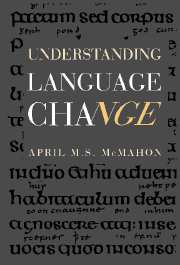Book contents
- Frontmatter
- Contents
- Preface and acknowledgements
- 1 Introduction
- 2 Three views of sound change
- 3 Sound change 2: the implementation problem
- 4 Morphological change
- 5 Syntactic change 1: the Transparency Principle
- 6 Word order change and grammaticalisation: language change and general laws
- 7 Semantic and lexical change
- 8 Language contact
- 9 Linguistic variation
- 10 Pidgins and Creoles
- 11 Language death
- 12 Linguistic evolution?
- Bibliography
- Index
4 - Morphological change
Published online by Cambridge University Press: 05 June 2012
- Frontmatter
- Contents
- Preface and acknowledgements
- 1 Introduction
- 2 Three views of sound change
- 3 Sound change 2: the implementation problem
- 4 Morphological change
- 5 Syntactic change 1: the Transparency Principle
- 6 Word order change and grammaticalisation: language change and general laws
- 7 Semantic and lexical change
- 8 Language contact
- 9 Linguistic variation
- 10 Pidgins and Creoles
- 11 Language death
- 12 Linguistic evolution?
- Bibliography
- Index
Summary
Introduction
We move now from the study of change in the phonetics and phonology to change in other areas of the grammar, and specifically to change in the morphology, or the structure of words. Morphology, of course, is not isolated from other components of the grammar, and integrates both synchronically and diachronically with the phonology and syntax. For instance, most Modern English nouns make their plurals by adding -s, whereas a few, like foot, instead change the stem vowel in the plural. Historically, the foot – feet alternation was part of the phonology, not the morphology: in earlier *fōt – *fōti, the final vowel showed plural number, but the sound change of i-mutation subsequently fronted /o:/ whenever /i/ appeared in the next syllable, giving fēt – *fōti. The vowel in the plural form unrounded in OE to give fēt, and the suffix dropped, leaving fōt – fēt, which ultimately became foot - feet. This loss of the final -i meant that the changed stem vowel was no longer predictable on the basis of phonological context, becoming instead a morphological fact about a particular word. Syntactic features may also become morphological: for example, auxiliary verbs may in time cease to be independent units and instead attach themselves to the main verb as person, number or tense affixes. This process of morphologisation of syntactic elements, known as grammaticalisation, will be discussed much more fully in Chapter 6.
- Type
- Chapter
- Information
- Understanding Language Change , pp. 69 - 106Publisher: Cambridge University PressPrint publication year: 1994



